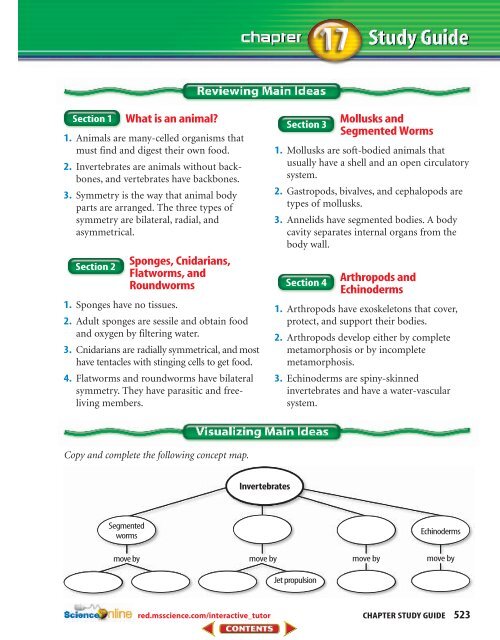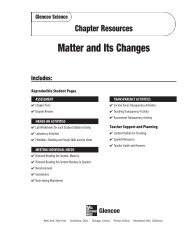Chapter 17: Invertebrate Animals
Chapter 17: Invertebrate Animals
Chapter 17: Invertebrate Animals
You also want an ePaper? Increase the reach of your titles
YUMPU automatically turns print PDFs into web optimized ePapers that Google loves.
What is an animal<br />
1. <strong>Animals</strong> are many-celled organisms that<br />
must find and digest their own food.<br />
2. <strong>Invertebrate</strong>s are animals without backbones,<br />
and vertebrates have backbones.<br />
3. Symmetry is the way that animal body<br />
parts are arranged. The three types of<br />
symmetry are bilateral, radial, and<br />
asymmetrical.<br />
Sponges, Cnidarians,<br />
Flatworms, and<br />
Roundworms<br />
1. Sponges have no tissues.<br />
2. Adult sponges are sessile and obtain food<br />
and oxygen by filtering water.<br />
3. Cnidarians are radially symmetrical, and most<br />
have tentacles with stinging cells to get food.<br />
4. Flatworms and roundworms have bilateral<br />
symmetry. They have parasitic and freeliving<br />
members.<br />
Mollusks and<br />
Segmented Worms<br />
1. Mollusks are soft-bodied animals that<br />
usually have a shell and an open circulatory<br />
system.<br />
2. Gastropods, bivalves, and cephalopods are<br />
types of mollusks.<br />
3. Annelids have segmented bodies. A body<br />
cavity separates internal organs from the<br />
body wall.<br />
Arthropods and<br />
Echinoderms<br />
1. Arthropods have exoskeletons that cover,<br />
protect, and support their bodies.<br />
2. Arthropods develop either by complete<br />
metamorphosis or by incomplete<br />
metamorphosis.<br />
3. Echinoderms are spiny-skinned<br />
invertebrates and have a water-vascular<br />
system.<br />
Copy and complete the following concept map.<br />
<strong>Invertebrate</strong>s<br />
Segmented<br />
worms<br />
Echinoderms<br />
move by<br />
move by<br />
move by<br />
move by<br />
Jet propulsion<br />
red.msscience.com/interactive_tutor<br />
CHAPTER STUDY GUIDE 523














